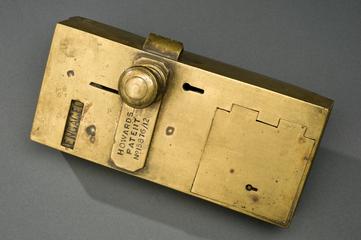
Lateral flow test used in Liverpool mass testing programme
- maker:
- National Health Service
Lateral flow COVID-19 testing kit including unused swab, used SARS-CoV-2 Antigen Test Cartridge (lot number X2010005 made 22 October 2022) for Innova, bottle of buffer solution, made 16 September 2020, buffer solution tube, sealed sterile swab Gongdong® brand, made by Zhejiang Gongdong Medical Technology Co Ltd, manufactured 20 October 2020, lot 2010003 blank Registration card for lateral flow test by HM Government and NHS with QR code and reference number TC1564, of the type used at various testing sites as part of the UK's first citywide mass testing programme held across Liverpool from November 2020
Between November 2020 and April 2021 more than 280,000 people living and working in Liverpool took part in the SMART pilot programme to trial mass testing of people with no COVID-19 symptoms. This means that over half of the population of Liverpool were involved. Liverpool was chosen for the pilot because in October and November 2020 there were particularly high numbers of COVID-19 cases in the city.
The SMART pilot was one of the first to try widespread use of lateral flow tests. Unlike the polymerase chain reaction (PCR) tests that had been used previously, lateral flow tests do not need to be sent to a lab and can give you a result in less than 30 minutes. During the pilot, nearly 6,000 people took part in a quality assurance exercise to assess the accuracy and usefulness of lateral flow tests. As scientists expected, the quality assurance exercise found that lateral flow tests were less sensitive than PCR tests and only picked up people with a high viral load. However, scientists argued that they are still a useful public health tool when regular lateral flow tests are done and when the results of them are treated cautiously rather than as a green light for activities.
Like the impact of COVID-19, the uptake of tests in Liverpool was unequal. Test uptake was lower and infection rates were higher in more deprived areas. Researchers identified that the fear of having to self-isolate and therefore losing income was a large barrier to testing in some areas. There were also issues around digital literacy and the accessibility of testing.
Details
- Category:
- Public Health & Hygiene
- Object Number:
- 2022-91
- Materials:
- paper (fibre product) and plastic (unidentified)
- Measurements:
-
overall (swab): 3 mm x 197 mm x 35 mm,
overall (buffer): 65 mm x 18 mm x 18 mm,
overall (cartridge including package): 4 mm x 140 mm x 79 mm,
overall (tube): 48 mm x 10 mm x 10 mm,
overall (card): 147 mm x 105 mm
- type:
- diagnostic test




